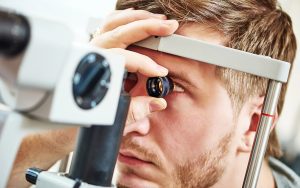Is Virtual Reality Tech Bad For Your Eyes?

Virtual reality, or VR, has been a massive game-changer in the tech world. Many people have tried the immersive experience and follow the technology closely. It has been predicted that VR technology will redefine the use of the internet and how we perceive our daily lives.
However, as its continued popularity grows, it is essential to consider some of the repercussions of the experience on your eyesight health. So let us take a look at some of the effects of VR on your eyes.
How Does Virtual Reality Work?
There are a couple of ways to experience the virtual world. However, one of the most common devices used is VR headsets. Screens and speakers are mounted inside the headset for the virtual experience.
The reality bit of it is made from an interactive and realistic three-dimensional world created by a computer. The headset tracks all your movements, enabling you to interact with your virtual environment.
One of the most important uses for VR headsets is their utilization in games and training. In addition, virtual reality has also become popular in the medical field; for virtual medical training and virtual reality therapy.
If you are a virtual reality enthusiast, it is always better to get advice from your optometrists to ensure a better eye and overall health.
What Are The Effects Of VR On Your Eyes?
VR headsets are not as safe as you might think. Continued research has shown that long-term use of virtual reality can negatively affect your eyesight. Let us explore some of these effects.
Increased Eye Strain
Anytime you stare at a device for a prolonged period, it will cause your eyes to strain. One of the reasons this happens is continued concentration and focus on a particular point. This also slows down your blinking, which contributes to dry eyes. Though eye-straining is only temporary, the discomfort can be problematic.
Blurred Or Cloudy Vision
You might experience cloudy or blurred vision after using your headset too often. This results from prolonged exposure to rapid changing of light and eye muscle adjustment. However, the distorted vision should only last for a moment.
Complications With Existing Eye Conditions
Your existing eye condition can worsen with the continued use of VR devices. The immersive experience of the VR devices includes alterations to depth perception, which can pose challenges when focusing. Over time, you might notice that your symptoms are becoming more profound.
Headaches And Fatigue
Increased eye strain is one of the causes of fatigue. As your eye muscles continually try to adjust to the virtual environment, they get overworked. You may also experience headaches after prolonged use of your virtual headset.
Visually Induced Motion Sickness
Have you heard of cyber-sickness? It is a common condition that results from VR experiences. Vertigo or motion sickness occurs when your brain gets disoriented by movement.
However, when using a VR set, your brain is tricked into thinking that you are in motion leading to sensory disorientation. Your inner ear is responsible for detecting your body balance and movement. The visual and auditory stimulations from the headset can induce motion sickness.
Dizziness
As we previously stated, your inner ear is responsible for maintaining body balance and perceiving body movement. Auditory stimulations might lead to sensory disorientation from the perceived virtual reality experience.
With the confused perception of reality, your brain tries to adapt to the rapid stimulations, throwing it off guard. This can make you lose balance and feel dizzy.
Eye Twitching
When using a VR headset, prolonged exposure to light can cause rapid muscle twitching in your eye. The simulation can have quick light flashes, which require your eyes to adjust and focus quickly. Over time, these quick adjustments can affect your eye muscles, leaving them twitching and strained.
Are Headsets Safe For Kids?
VR headsets are not safe for kids. With the continued growth of VR environments for gaming purposes, kids are at the highest risk of suffering from eye-related conditions.
During childhood, depth perception, focus, and tracking are still developing. Continued VR use can alter vision development, causing early development of myopia, eye straining, and discomfort.
How To Avoid The Harmful Effects Of VR
One of the solutions to minimize your risk of harmful VR effects is to reduce the amount of time spent during your virtual experience. Try adopting the 20-20-20 rule. After every 20 minutes in your virtual environment, take off the headset and focus on a spot 20 feet away for about 20 seconds. This gives your eyes time to adapt, refocus, and relax to prevent eye strain.
Remember to keep blinking to prevent further eye strain or cloudy or blurred vision. This also applies to any other screens that you use.
You can also customize your headset to suit particular needs. These adjustments include focal distance and strap alterations to make the experience more comfortable.
In addition, if you cannot keep your kid away from the VR set, then try to minimize their screen time to about five minutes. This reduces the risk of developing early eye conditions.
Are There Any Benefits To Using VR Headsets?
Using your VR is not all that bad. On the contrary, your eyes can substantially benefit from using the headsets.
One of the most common uses for VR machines is conducting eye examinations. Your optometrist can use the device to help them understand focus issues and muscle imbalances. Furthermore, research shows that VR sets are efficient tools in treating lazy eye (amblyopia), vergence dysfunction, and lack of stereo depth perception.
In A Nutshell
Though VR has gained a lot of popularity, special attention needs to be taken to deal with your eye and overall health. Reducing the time you spend on your headset is a perfect way to reduce its harmful effects.
Though there are adverse effects to your VR experience, fine-tuning your headset might also improve your vision if done appropriately. However, always consult your eye doctor if you seek alternative eye treatment therapies.
If you want to learn more about the risks and benefits of VR or have any eye-related questions, make an appointment with Anaheim Eye Institute, and our team will give you the help you need.




